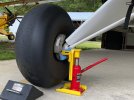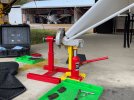tbienz
Well-Known Member
OK...I'll bite. Bumper is complaining that there's nothing on the forum to discuss, so if anybody's bored, perhaps you could assist me with my upcoming project of putting these somewhat ridiculously large looking AK Bushwheels on the Husky.
I think I've read the old posts about hoists, spreader bars and "racing jacks." My Husky doesn't have lift rings and I was hoping to avoid taking apart the cowling and using an engine jack to lift the plane by its engine mount every time I want to swap or rotate the tires. The "racing jack" isn't anything special, it looks just like the large floor jack I use to service my cars/heavy equipment.
The problem I see is that the lower end of my gear leg ('94 A-1) sweeps down toward the wheel at an angle such that the lifting plate of most jacks would have a tendency to slide off as you start to lift. My tentative plan is to use the large floor jack, tie the tire to the lifting plate to keep it from sliding inward and jack up the leg...once the side is high enough to make the gear leg sweep relatively parallel to the surface of the lifing plate I'll untie the tire, change it, re-tie the tire and let it down.
How about supporting the tail while chaning the rear tire/wheel/spring? Just lift it by hand and set it down on a padded sawhorse near the handles projecting from the longerons? (that's probably spelled wrong).
How about a long 2x4 sitting on top of the lift plate of the jack pushing up on the bottom of the tie down ring with padding and a depression cut in end of the piece of wood to keep it from slipping off and driving up through the wing?
There must be a reasonable work-around for this issue???
--Thomas
I think I've read the old posts about hoists, spreader bars and "racing jacks." My Husky doesn't have lift rings and I was hoping to avoid taking apart the cowling and using an engine jack to lift the plane by its engine mount every time I want to swap or rotate the tires. The "racing jack" isn't anything special, it looks just like the large floor jack I use to service my cars/heavy equipment.
The problem I see is that the lower end of my gear leg ('94 A-1) sweeps down toward the wheel at an angle such that the lifting plate of most jacks would have a tendency to slide off as you start to lift. My tentative plan is to use the large floor jack, tie the tire to the lifting plate to keep it from sliding inward and jack up the leg...once the side is high enough to make the gear leg sweep relatively parallel to the surface of the lifing plate I'll untie the tire, change it, re-tie the tire and let it down.
How about supporting the tail while chaning the rear tire/wheel/spring? Just lift it by hand and set it down on a padded sawhorse near the handles projecting from the longerons? (that's probably spelled wrong).
How about a long 2x4 sitting on top of the lift plate of the jack pushing up on the bottom of the tie down ring with padding and a depression cut in end of the piece of wood to keep it from slipping off and driving up through the wing?
There must be a reasonable work-around for this issue???
--Thomas



